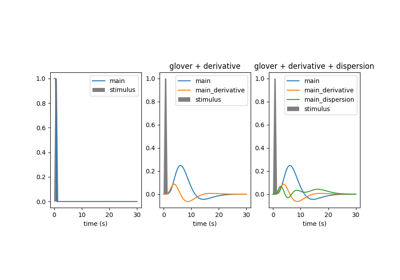Note
This page is a reference documentation. It only explains the function signature, and not how to use it. Please refer to the user guide for the big picture.
3.2.7. nistats.hemodynamic_models.compute_regressor¶
-
nistats.hemodynamic_models.compute_regressor(exp_condition, hrf_model, frame_times, con_id='cond', oversampling=50, fir_delays=None, min_onset=-24)¶ This is the main function to convolve regressors with hrf model
- Parameters
- exp_conditionarray-like of shape (3, n_events)
yields description of events for this condition as a (onsets, durations, amplitudes) triplet
- hrf_model{‘spm’, ‘spm + derivative’, ‘spm + derivative + dispersion’,
‘glover’, ‘glover + derivative’, ‘fir’, None} Name of the hrf model to be used
- frame_timesarray of shape (n_scans)
the desired sampling times
- con_idstring
optional identifier of the condition
- oversamplingint, optional
oversampling factor to perform the convolution
- fir_delays[int] 1D-array-like, optional
delays (in scans) used in case of a finite impulse response model
- min_onsetfloat, optional
minimal onset relative to frame_times[0] (in seconds) events that start before frame_times[0] + min_onset are not considered
- Returns
- computed_regressors: array of shape(n_scans, n_reg)
computed regressors sampled at frame times
- reg_names: list of strings
corresponding regressor names
Notes
- The different hemodynamic models can be understood as follows:
‘spm’: this is the hrf model used in SPM
‘spm + derivative’: SPM model plus its time derivative (2 regressors)
- ‘spm + time + dispersion’: idem, plus dispersion derivative
(3 regressors)
‘glover’: this one corresponds to the Glover hrf
‘glover + derivative’: the Glover hrf + time derivative (2 regressors)
- ‘glover + derivative + dispersion’: idem + dispersion derivative
(3 regressors)
- ‘fir’: list or array,
finite impulse response basis, a set of delayed dirac models.
It is expected that spm standard and Glover model would not yield large differences in most cases.
In case of glover and spm models, the derived regressors are orthogonalized wrt the main one.

